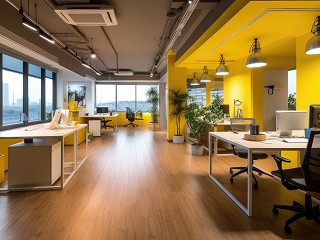The Impact of Office Colours and Materials
A well-designed office space has the potential to significantly influence the productivity, creativity, and overall well-being of its occupants. When it comes to office fit-outs, two key elements that play a crucial role in shaping the work environment are colour and materials. In this blog post, we will explore the fascinating ways in which colour and different materials can affect office workers, and how strategic choices in these areas can contribute to a positive and thriving workplace.
The Power of colour Psychology:
colour psychology is the study of how different colours can evoke specific emotional and physiological responses in individuals. When applied strategically in office fit-outs, colours can greatly impact the mood, focus, and productivity of employees. Here are a few key colour considerations:
colour can be a powerful tool in influencing the atmosphere and ambiance of an office space. Blue, for example, is known to promote a sense of calmness, focus, and productivity. Incorporating shades of blue in office spaces, such as in wall colours or furniture accents, can help reduce stress levels, improve concentration, and encourage a tranquil working environment.
Similarly, green, being associated with nature and harmony, can have a positive effect on office workers. Adding touches of green, such as indoor plants or green accents, can create a sense of balance and relaxation, leading to increased well-being and improved cognitive performance.
On the other hand, yellow is often associated with energy, optimism, and creativity. Introducing pops of yellow in workspaces, such as in artwork or decor, can stimulate creative thinking, boost mood, and create a vibrant and positive atmosphere.
Impact of Materials on Office Workers:
The choice of materials used in office fit-outs can significantly influence the comfort, acoustics, and overall ambiance of the workplace. Here are a few examples:
Incorporating natural elements such as wood, stone, or plants can create a connection to the natural world, fostering a sense of calmness and well-being. Biophilic design principles, which integrate nature into the built environment, have shown to enhance creativity, reduce stress, and increase productivity. Adding wooden furniture, planters, or even a living green wall can create a visually appealing and soothing work environment.
Investing in ergonomic furniture is crucial for employee well-being. Comfortable chairs, adjustable desks, and supportive accessories can improve posture, reduce the risk of musculoskeletal disorders, and enhance overall physical health, leading to increased productivity and satisfaction.
Another important consideration is the acoustics of the office space. Excessive noise levels can disrupt concentration and increase stress. The use of sound-absorbing materials, such as acoustic panels or carpets, can help minimise noise pollution, improve speech intelligibility, and create a more peaceful and productive environment.
Conclusion:
Creating a well-designed office space involves more than just functionality. The strategic use of colour and materials in office fit-outs can significantly impact the well-being, productivity, and overall satisfaction of employees. By understanding the principles of colour psychology and incorporating appropriate materials, companies specialising in office fit-outs can help create work environments that foster creativity, reduce stress, and promote a positive and thriving workplace culture. A thoughtfully designed office space is an investment in the success and happiness of both employees and the organisation as a whole. Remember, colours and materials have the power to transform an ordinary workspace into an inspiring and productive haven.
